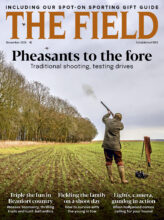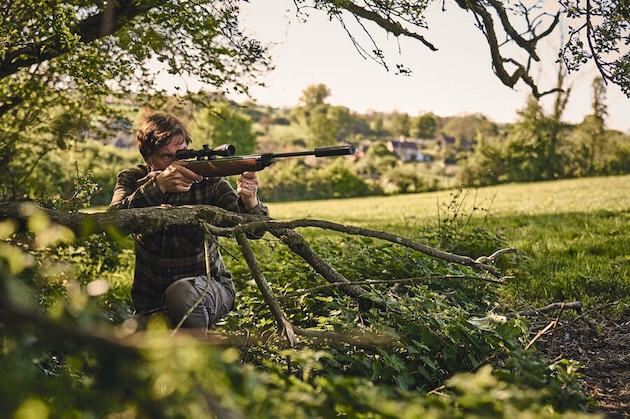Simple, accessible and undeniably rewarding, airgun shooting is a great way to harvest wild meat while bringing problematic rabbits to book, writes Mat Manning
Like many fieldsportsmen, my earliest memories of forays in the field take me back to shooting rabbits on warm summer evenings. I count myself fortunate to have had a grandfather who worked as a herdsman on a dairy farm for an owner grateful for help keeping numbers of those grass-gobbling pests at bay. This created a wonderful opportunity to put my airgun to good use.
Rabbits have experienced some tough times since those distant days in the late 1980s. Myxomatosis has taken its toll and, more recently, colonies up and down the country have been decimated by rabbit haemorrhagic disease. Yet whatever fate throws at them, rabbits have a remarkable ability to bounce back. The old adage ‘breeding like rabbits’ is no myth: sure enough, they are showing encouraging signs of recovery. Not only are rabbits once again becoming a common sight on much of the ground I shoot over but numbers on some holdings have spiralled so high that they are causing serious damage and must be kept in check.

Rabbits post a significant risk of injury to livestock, particularly in pony paddocks
In the past the main reason for rabbit control was to prevent them from munching through crops. While that is still the case on many farms, the risk of injury to livestock is probably the chief motivation for keeping numbers down today. A field margin pitted with rabbit burrows may look harmless but those excavations can result in an expensive vet bill or worse if a hoof finds its way into one of them.
Uncomplicated kit
Thankfully, the control of rabbits needn’t be a complicated affair. An air rifle is perfect for the job. Plus, if you opt for a sub-12ft/lb (foot-pound) model, you don’t need a licence to own one. Modern precharged air rifles make easy work of the task, thanks to the pinpoint accuracy of their recoilless firing cycle, but simpler spring-powered models are equally effective as long as you know your limits. So, if rabbits are causing problems on your patch, get out there, bring them to book and you’ll be rewarded with something delicious and healthy for supper. (Read: How Britain became a world leader in airgun development.)

The writer breaks the barrel of his airgun to recock the spring and load a pellet
Most of us will have some form of airgun at home but if you are looking to upgrade then Weihrauch, BSA and Air Arms make some excellent spring-powered models that, unlike precharged airguns, don’t entail the extra hassle and expense of a scuba tank or stirrup pump to fill them with compressed air. Whatever airgun you are shooting with, it is worth investing in a telescopic sight that makes it easier to consistently shoot with the precision to deliver the all-important headshots that will ensure a swift despatch.
It is also crucial to pair your airgun with the right pellet: the classic domed profile tends to be the most accurate. If you can, try two or three different pellet types from reputable brands such as JSB, H&N, Rifle and QYS because it is likely that your airgun will shoot more accurately with one than the others. This experimentation is worthwhile as even a mediocre airgun can display a marked improvement in accuracy when matched with the right pellet.

Lining up for a shot after stalking to within a comfortable shooting distance
Practice sessions on your garden range (it is safe and legal to shoot a sub-12ft/lb airgun in a moderately sized garden with a few sensible precautions – the main one being a dependable backstop) are also the only way to answer the age-old question of ‘what is the maximum distance at which an airgun can kill a rabbit?’ The maximum effective range will be the distance at which you can consistently land pellets inside a circle the size of a £2 coin – remembering you have to be able to do it from whatever stance you will be using in the field.
Next, set up targets at five-metre intervals from 15 metres out to your maximum effective range. An airgun pellet has a distinctly curved trajectory as it emerges from the barrel beneath the line of sight before correlating with the cross hairs at around 15 metres and then rising a little above the cross hairs before dropping back down to correspond with your 25-metre zero and finally running out of steam and falling to the ground. Aim directly at the bullseye on those staggered targets and the rise and fall is clear to see. You can then work on the amount of hold-over or hold-under needed to keep the pellet dead on target as it travels downrange.
Tread carefully
Spotting rabbits is one thing, shooting rabbits is quite another. These born survivors are equipped with finely tuned senses evolved over millennia to help them locate and avoid predators. Their eyesight isn’t excellent but remarkable hearing compensates, plus a phenomenal sense of smell and an uncanny ability to detect vibrations through the ground. Bearing all that in mind, ditch wellies for something lighter to prevent sending your quarry running for their burrows.
Keep things simple and rove along the field edges during the last hour or two of daylight when hungry lagomorphs venture out to feed on dew-softened stems. A recent foray saw me doing just that when I visited a friend’s pony paddocks. Two friendly ponies ruled out the paddock where the rabbits were most active. Nonetheless, there were plenty of signs of rabbits in the adjoining field. Grass along the margins had been cropped to a tight stubble and bare patches of earth were scattered with currant-like droppings. Things looked even more promising in the next empty paddock where two rabbits were feeding just out from the hedgerow.
Before attempting to stalk within striking distance of those rabbits, I took a moment to study the ground between us. They were about 90 metres away and I noted a fallen branch that I reckoned would put me about 25 metres from them if I could reach it. Keeping close to the hedge and as low as possible, I took slow, gentle steps, stopping frequently to observe the rabbits and check the ground ahead of me for hazards such as dry twigs that might snap conspicuously under a clumsy foot. As I reached the halfway mark, one of the rabbits stopped feeding and sat bolt upright. I froze dead still. The rabbit eventually relaxed again and turned its attention back to the sweet grass stems – my cue to resume the stalk with heightened caution.
On reaching the intended firing point, a quick count of the fence posts between my position and the quarry confirmed a range of around 25 metres. Leaning on the branch for added stability, I shouldered my Weihrauch HW95K. Peering through the scope, the cross hairs were soon set on the head of the closest rabbit. I pushed off the safety catch, steadied my aim and squeezed through the trigger to unleash a shot that hit home with a crack that rang out through the warm evening air. The rabbit rolled over while its startled mate did the sensible thing and disappeared into the brambles.
This first stalk ended in success but the next two didn’t go so well as rabbits sensed my approach and made themselves scarce. Watching rabbits slip away into cover before you can get within range is frustrating but there is a way around this all-too-common problem: to wait for them to come to you. Adopting sit-and-wait tactics eliminates most of the noise and movement that can alert rabbits to your presence, and the only thing it requires is patience. Returning to an area where I had seen signs of rabbit activity on my outward journey, I tucked myself against the hedge about 25 metres from the main burrows on the opposite side of the field corner.

Rabbit for supper. A spring-powered airgun is well up to the task of rabbit shooting as long as you know your limits and shoot responsibly.
A straightforward shot
This tactic works best at dusk when rabbits have spent the day underground avoiding predators and are eager to get out and feed. Sure enough, one emerged from the undergrowth about 20 minutes after I had settled in. It was comfortably within range and the fact that I was already sitting made for a straightforward shot resulting in another addition to the bag. However, the discomfort of sitting hunched on the ground eventually forced me to break cover.
That marked the end of my evening on rabbit-control duties, and my final task was to paunch the brace in a secluded field corner where badgers or foxes would no doubt clear up any trace of my gutting operations before sunrise. Incidentally, if you’d prefer to avoid pregnant does, eliminate the risk by only targeting rabbits that are half- to three-quarters grown. As well as being less likely to be carrying kits, these younger rabbits are also more tender and therefore excellent to eat.
Walking back across the paddocks in the fading light, bats replaced swallows in the darkening sky and I was returning home after a good job done with delicious free-range meat for the larder. Controlling rabbits with an airgun is accessible and rewarding, and also serves as an excellent way to introduce youngsters to shooting sports. So dig out the air rifle and get set for summer shooting.





